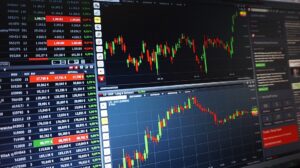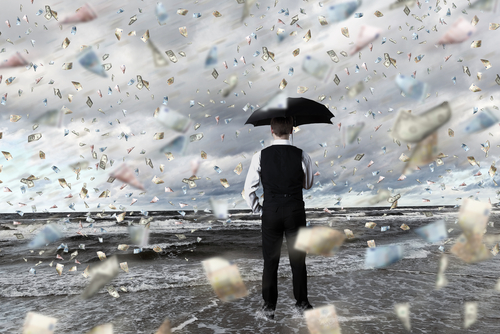With hurricane Irma in the rear-view mirror, it is once again clear there is value in being prepared for rough times. And since we’ve experienced hurricanes many times before, we know what to expect and how to prepare. A week before the storm, we start to pay close attention to the “cone of uncertainty” and the forecast tracks. If the storm is strong and seems to be heading our way, we prepare our homes and decide to stay or evacuate.
The storm hits. The wind howls. The rain pours. We hear debris hitting our homes. We lose power. We get leaks. We sweat. We worry. We sit in the dark and wonder how bad it is going to get. In short, it is more than merely unpleasant. Eventually, the storm passes and we emerge from our shuttered homes to assess the damage, start repairs and clean up. No one likes any of it but to enjoy Florida, one has to deal with these storms. In a relatively short period of time, we return to normalcy.
If we are prepared and make good decisions, we should be fine because we know what to expect.
Financial storms are similar in some respects. If we are prepared and make good decisions, we should be fine because we know what to expect. October 2017 marks the tenth anniversary of the high point of the U.S. stock market before the financial crisis of 2008 and the Great Recession. Over the next couple of years, the media will revisit many of the events that unfolded and it may all seem predictable. It was a fantastic opportunity for market-timing but we have not seen any credible party claim, let alone demonstrate, that they got out of the market early enough (before the crisis) AND back in the market early enough to outperform prudent investors who stayed the course. It is more important to be resilient than nimble.

The coming of the next bad market is inevitable but the exact timing, strength, and duration are unpredictable. For every Irma, there are many hurricane Jose’s that look like they could be a problem but end up doing little harm.
On average, you should expect at least one 5% decline every year. There have only been four years since 1950 (1954, 1958, 1964, and 1995) that did not have such a decline. 10% drops, often called “corrections” happen on average every other year. Again, that’s on average. We had two in 2016. A “bear market” usually refers to declines of 20% or more and come every 5-6 years or so and average -32% over 15 months[i]. With drops like that, it means the stomach is at least as important as the brain when it comes to investment management.
Despite their frequency, all corrections and bear markets, no matter how severe, ended and in time the market returned to all-time highs. Although that is no guarantee about the future, it is a track record which should not be forgotten.
The biggest problem in a bear market really isn’t about the market – it is investor behavior. It is easy to get caught up in the emotion of it all and cast aside the perfect record of recovery by the stock market.
The biggest problem in a bear market really isn’t about the market – it is investor behavior. It is easy to get caught up in the emotion of it all and cast aside the perfect record of recovery by the stock market. Below is a typical example of how financial storms usually play out.
First, the market declines a little, say 5%. The media will ascribe the decline to some event. Commentators will draw comparisons to other similar events and imply that the next 2008/2009 sized decline is coming. The Federal Reserve interest rate changes are a favorite for the media to cite. Some of these “crises” are actually memorable events such as the nuclear disaster in Japan or Brexit, but many are not. Most people ignore this because 5% is not that bad and the market usually heads back up fairly quickly.
But then, the market goes down more and we have a “correction.” Only 11 of the 37 corrections since 1950 have continued to become bear markets. But in all 37 cases, the voices of doom became a little louder and were heard more frequently. Most people still ignore it but a few get antsy.

A parade of pundits urge, even plead, for you do something to protect yourself. Terms like “dead cat bounce” and “catch a falling knife” find its way into the pleas. Because it is so bad and going to get worse, you are told you can’t rely on what has worked in the past. In 2009, after a 50% decline in stocks, many pointed out that it takes a 100% positive return to erase a 50% decline, so it could take a decade to recover.
That math is correct but irrelevant to true investors because recovery times based on how people are actually affected and can actually invest have been much faster. Since 1900, the average recovery period after a bear market low is just over two years adjusting for inflation and dividends.[ii] The most striking difference between an accurate statistic and a more realistic experience is seen with the Great Depression. The provocative and irrelevant statistic is that it took 25 years for the Dow to get back to its 1929 level. Wow! That’s awful but the actual experience of a diversified, disciplined, and patient investor was likely very different.
Even if someone was invested in the same 30 stocks that made up the Dow in the same proportion, they would have had to refuse any dividends paid by those companies to suffer through a 25-year recovery. No one would do that even if they could. According to one study, the market as a whole only took four years and five months from its low to regain its 1929 purchasing power.[iii]
…next thing you know, instead of thinking and behaving as an investor, you ignore why you are invested the way you are and shorten your time frame.
Anyway, once the bear growls, next thing you know, instead of thinking and behaving as an investor, you ignore why you are invested the way you are and shorten your time frame. You start listening to people and pitches you would not have given any consideration to before the drop but now you wonder if this time really is different.
One thing you do not need at this point is a panicked advisor. A lot of people don’t work with real advisors, let alone good advisors, they work with sales people. Since 2008, many people moved out of perfectly good portfolio strategies to buy lousy products touted for guarantees or some form of downside risk mitigation. After things settled down and the markets didn’t look so scary, these people were left with holdings that are not likely to get them to their financial goals.
The better approach is to be prepared with a well-structured, diversified, low cost, tax efficient portfolio appropriate for your goals and your ability to stomach declines and stick to it when times are tough. We didn’t enjoy 2008 but we knew what to do. We didn’t just sit there. We preached calm, patience, discipline and tax-smart rebalancing. That rarely works out quickly but in retrospect it has always worked out quickly enough. Investors have a proven course to stay – speculators don’t!
Instead of worrying about when the next bad market is going to come, revisit your goals and recommit to your plans. When the storm comes, you should be okay. Invest, don’t speculate.
[i] Azzad Asset Management
[ii] Hulbert Financial Digest study
[iii] “25 Years to Bounce Back? Try 4 ½”, New York Times 4/25/09
News & Notes
Tax reform effort begins: On September 27th, the White House released a summary of its tax reform proposals. The document gives a little more detail than prior descriptions but not enough to crunch very specific numbers. Further negotiations and debate is expected. You can read it yourself here. There is often a significant difference between proposed changes and enacted law so it is a little too early to determine with certainty what will change. Nonetheless, we will be happy to discuss how the proposed changes could affect your particular circumstances the next time we speak.
More on the Equifax security breach: As we described in our commentary last month, credit reporting bureau Equifax had their systems hacked, exposing the records of about 143 million people. There are steps you can take to protect yourself from credit-related identity theft. We are mentioning this again because it is the most significant data breach in history. If you haven’t decided what to do, see our commentary and note we added a fourth credit bureau, Innovis. The strongest form of protection you can place on your credit is a credit freeze. Here is the contact information for all four bureaus:
- Equifax— 1-800-349-9960
- Experian— 1‑888‑397‑3742
- TransUnion— 1-888-909-8872
- Innovis— 1-800-540-2505
Please remember to call us: When anything significant happens in your life, including changes in your finances, family, or health that could affect your financial plan, please let us know so that we can adapt our planning and portfolio work for you accordingly. Also, if you ever fail to receive a monthly statement for one of the Schwab Institutional or TD Ameritrade Institutional accounts under our management, please let us know so we may assure the respective custodian delivers your statements promptly.
Yours truly,
The Team at Moisand Fitzgerald Tamayo, LLC

